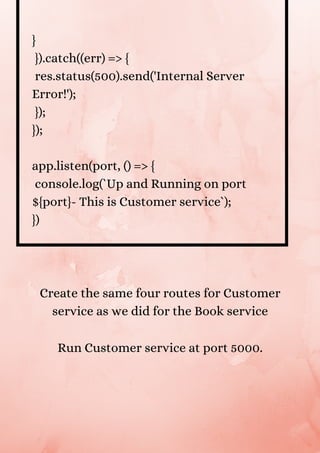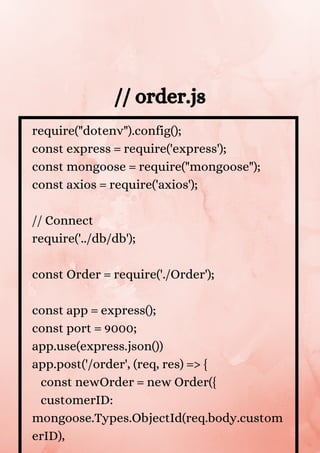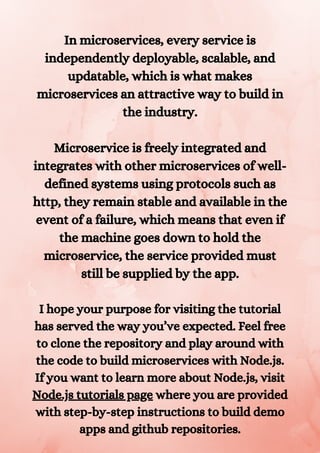How to build microservices with node.js
- 1. How to Build Microservices with Node.js www.bacancytechnology.com
- 2. Divide into independent chunks to build the entire application.
- 3. Introduction
- 4. In the last blog, we learned about Microservice Architecture and Why Build Microservices with Node.js. If you haven’t explored or read much about Microservice Architecture then I would recommend visiting our last blog, to have basic theoretical knowledge. The blog deals with What, Why, and When with Microservices. We will cover the remaining question ‘How’ in this tutorial. You are exactly right! In this tutorial, we will learn how to build a basic demo application for illustrating Microservices with Node.js. The tutorial will consist of basic and simple steps that you can follow with us and start building your own demo app. Without further ado, let’s get started with our application.
- 6. In this demo application, we will build microservices with NodeJS which will connect to an external API. The app will have three services: Book, Customer, and Order services. Each of the services will have individual servers running on different ports. These services will communicate with each other through REST APIs. We all know that if it wasn’t microservices architecture we would have only one server running. But, in microservices architecture the scenario is different. So, this was about what we are building in this tutorial, let’s get started with the coding part.
- 8. Make sure you have Node.js installed. Visit Nodejs.org to download the latest Node version, if your system doesn’t have Node.js. Run npm init in the project root folder. This will create a package.json file that will create certain questions about the package, if you are not sure how to respond you can use the default. We will use four packages, Express, mongoose, axios, and dotenv which can be installed as follows: $ npm install express mongoose axios dotenv --save
- 9. Project Structure Refer to the below image for the project structure. The structure can vary from person to person.
- 11. Let’s start with the basic step to establish a DB connection. In the db folder, create a db.js to code to connect the database. This is just a small demo app, but the large and complex applications also have different databases for individual services. // db.js const mongoose = require('mongoose'); mongoose.connect(process.env.MONGO_U RI, { useNewUrlParser: true, useUnifiedTopology: true, useFindAndModify: false, useCreateIndex: true }).then(() => { console.log('Connection successful!'); }).catch((e) => { console.log('Connection failed!'); })
- 12. In db.js, we have to require a mongoose package for MongoDB database connection. The function connect() will take two arguments – uri and options.
- 14. const mongoose = require('mongoose'); const bookSchema = mongoose.Schema({ title: { type: String, require: true }, author: { type: String, require: true }, numberPages: { type: Number, require: false }, publisher: { type: String, require: false Create a Book folder for Book service, inside the Book folder we will create Book.js for creating a Book Model. // Book.js
- 15. } }) const Book = mongoose.model("book", bookSchema); module.exports = Book; Now we will need to create a server for the Book service.
- 16. Create a Server for Book Service Create books.js inside the Book folder. Since we are learning to build microservices we will have different servers for services. // books.js require("dotenv").config(); const express = require('express'); // Connect require('../db/db'); const Book = require('./Book'); const app = express(); const port = 3000; app.use(express.json()) app.post('/book', (req, res) => { const newBook = new Book({...req.body});
- 17. newBook.save().then(() => { res.send('New Book added successfully!') }).catch((err) => { res.status(500).send('Internal Server Error!'); }) }) app.get('/books', (req, res) => { Book.find().then((books) => { if (books.length !== 0) { res.json(books) } else { res.status(404).send('Books not found'); } }).catch((err) => { res.status(500).send('Internal Server Error!'); }); }) app.get('/book/:id', (req, res) => { Book.findById(req.params.id).then((book) => {
- 18. if (book) { res.json(book) } else { res.status(404).send('Books not found'); } }).catch((err) => { res.status(500).send('Internal Server Error!'); }); }) app.delete('/book/:id', (req, res) => { Book.findOneAndRemove(req.params.id).then((b ook) => { if (book) { res.json('Book deleted Successfully!') } else { res.status(404).send('Book Not found!'); } }).catch((err) => { res.status(500).send('Internal Server Error!'); }); }); app.listen(port, () => { console.log(`Up and Running on port ${port} - This is Book service`); })
- 19. Add books Get all the books from the database Get a particular book Delete a book We have used express for creating a server, made the db file required for connecting with the database, and Book model for storing data. The Book service has four routes: Run book service at port 3000.
- 21. const mongoose = require('mongoose'); const CustomerSchema = mongoose.Schema({ name: { type: String, require: true }, age: { type: Number, require: true }, address: { type: String, require: true } }) const Customer = mongoose.model("customer", CustomerSchema); module.exports = Customer; Create a Customer folder for Customer service, inside the Customer folder we will have Customer.js for model, just like we did for Book service in the previous section. // Customer.js
- 22. Now we will need to create a server for Customer service. Create a Server for Customer Service We will have a separate server for Customer service as well. Create a file named customer.js. // customer.js require("dotenv").config(); const express = require('express'); // Connect require('../db/db'); const Customer = require('./Customer'); const app = express(); const port = 5000; app.use(express.json())
- 23. app.post('/customer', (req, res) => { const newCustomer = new Customer({...req.body}); newCustomer.save().then(() => { res.send('New Customer created successfully!'); }).catch((err) => { res.status(500).send('Internal Server Error!'); }) }) app.get('/customers', (req, res) => { Customer.find().then((customers) => { if (customers) { res.json(customers) } else { res.status(404).send('customers not found'); } }).catch((err) => { res.status(500).send('Internal Server Error!'); }); })
- 24. app.get('/customer/:id', (req, res) => { Customer.findById(req.params.id).then((cu stomer) => { if (customer) { res.json(customer) } else { res.status(404).send('customer not found'); } }).catch((err) => { res.status(500).send('Internal Server Error!'); }); }) app.delete('/customer/:id', (req, res) => { Customer.findByIdAndRemove(req.params. id).then((customer) => { if (customer) { res.json('customer deleted Successfully!') } else { res.status(404).send('Customer Not Found!');
- 25. } }).catch((err) => { res.status(500).send('Internal Server Error!'); }); }); app.listen(port, () => { console.log(`Up and Running on port ${port}- This is Customer service`); }) Create the same four routes for Customer service as we did for the Book service Run Customer service at port 5000.
- 27. const mongoose = require('mongoose'); const orderSchema = mongoose.Schema({ customerID: { type: mongoose.SchemaTypes.ObjectId, require: true }, bookID: { type: mongoose.SchemaTypes.ObjectId, require: true }, initialDate: { type: Date, require: true }, deliveryDate: { type: Date, require: false // Order.js Create an Order.js file inside the Order folder for model, just like we did for Book and Customer service.
- 28. } }) const Order = mongoose.model("order", orderSchema); module.exports = Order; Now we will need to create a server for the Order service. Create a Server for Order Service Create order.js inside the Order folder.
- 29. require("dotenv").config(); const express = require('express'); const mongoose = require("mongoose"); const axios = require('axios'); // Connect require('../db/db'); const Order = require('./Order'); const app = express(); const port = 9000; app.use(express.json()) app.post('/order', (req, res) => { const newOrder = new Order({ customerID: mongoose.Types.ObjectId(req.body.custom erID), // order.js
- 30. bookID: mongoose.Types.ObjectId(req.body.bookID) , initialDate: req.body.initialDate, deliveryDate: req.body.deliveryDate }); newOrder.save().then(() => { res.send('New order added successfully!') }).catch((err) => { res.status(500).send('Internal Server Error!'); }) }) app.get('/orders', (req, res) => { Order.find().then((orders) => { if (orders) { res.json(orders) } else { res.status(404).send('Orders not found'); } }).catch((err) => { res.status(500).send('Internal Server Error!');
- 31. }); }) app.get('/order/:id', (req, res) => { Order.findById(req.params.id).then((order) => { if (order) { axios.get(`http://localhost:5000/customer/ ${order.customerID}`).then((response) => { let orderObject = { CustomerName: response.data.name, BookTitle: '' } axios.get(`http://localhost:3000/book/${ord er.bookID}`).then((response) => { orderObject.BookTitle = response.data.title res.json(orderObject); }) }) } else { res.status(404).send('Orders not found');
- 32. } }).catch((err) => { res.status(500).send('Internal Server Error!'); }); }) app.listen(port, () => { console.log(`Up and Running on port ${port} - This is Order service`); }) Add an order. You need to pass bookId, customerId, initialDate, and deliveryDate for it. Get all the orders from the database Get customers and book details for a particular order. Run customer service at port 9000. We will create three routes in Order service:
- 33. To run the last route make sure all the services are running in the background. Because we are getting details from book service and customer service as well. So, this was a step-by-step guide to build microservices with Node.js. The entire source code is available here: nodejs- microservices-example
- 34. Conclusion
- 35. In microservices, every service is independently deployable, scalable, and updatable, which is what makes microservices an attractive way to build in the industry. Microservice is freely integrated and integrates with other microservices of well- defined systems using protocols such as http, they remain stable and available in the event of a failure, which means that even if the machine goes down to hold the microservice, the service provided must still be supplied by the app. I hope your purpose for visiting the tutorial has served the way you’ve expected. Feel free to clone the repository and play around with the code to build microservices with Node.js. If you want to learn more about Node.js, visit Node.js tutorials page where you are provided with step-by-step instructions to build demo apps and github repositories.
- 36. Are you looking for a helping hand for your NodeJS project? Do you need skilled and dedicated developers with NodeJS expertise? Then without wasting a second, contact us and hire NodeJs developers.





































